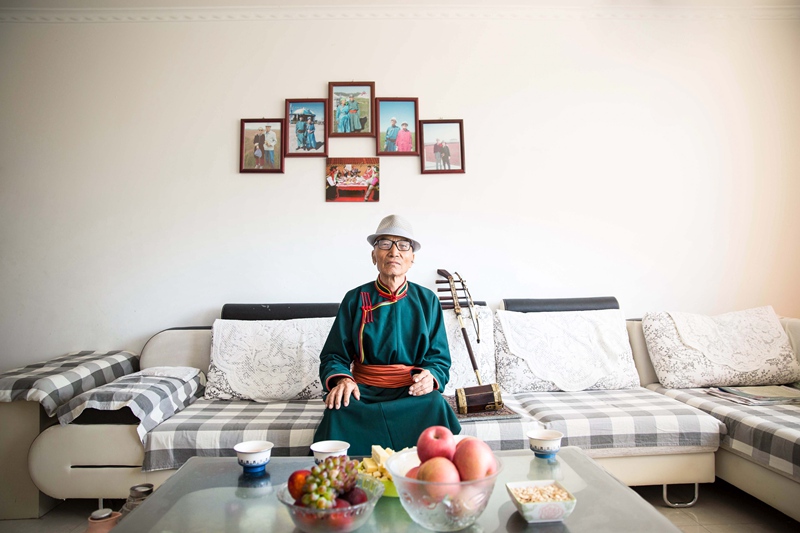


The“Epic of King Geser,” an ancient epic reputed by some to be the longest in the world. [Photo by Tanja Herko]
Holding his four-stringed fiddle, 77-year-old Raxiodser, a musician from Jarud Banner in Tongliao City, North China’s Inner Mongolia Autonomous Region, can still remember the texts of the “Epic of King Geser,” an ancient epic reputed by some to be the longest in the world.
Dating as far back as the 12th century, the epic relates to the heroic deeds of the cultural hero Gesar, the fearless lord of the legendary kingdom of Ling. In Inner Mongolia, the saga is named the “Epic of King Geser,” while in southwest China’s Tibet autonomous region, its name is “Gesar.” Although there is no one definitive text, the Chinese compilation of the Tibetan version has filled some 120 volumes, more than one million verses.
“Though the Epic has been circulating in Inner Mongolia and Tibet for hundreds of years, it was my uncle, Pajai, who compiled the Jarud Banner version. This version lasts 80 hours, including traditional Mongolian music and texts, while I’m the first generation inheritor,” said Raxiodser.

Pajai, Raxiodser’s uncle was received by many leaders, including Mao Zedong. [Photo by Tanja Herko]
Born into a family of artists, Raxiodser’s uncle Pajai collected ancient materials, compiling books and voice recordings of traditional Mongolian music. He spent years researching the epic, turning the dying oral traditions into a popular performing art.
“I’ve been studying Geser since I was a kid. Very few can memorize all the texts and sing them professionally. I’m almost 80 now, and I want to pass this tradition onto more people, so the story can survive and last forever,” said Raxiodser.
Thanks to the efforts of Raxiodser and other musicians in Inner Mongolia and Tibet, Geser was listed as a World Intangible Cultural Heritage in 2009, while the Jarud Banner version has been passed on to the third generation - students of Raxiodser.
Traditional art serves us all
Serving as a die-hard fan of traditional Mongolian art, Raxiodser has dedicated his whole life to the promotion of traditional culture. At the age of 16, he joined Ulan Muqir, a traveling art troupe performing for herdsmen in remote areas.
“Traditional art originated from the people. Though I only have a primary school education level, Ulan Muqir served as my university. Here I learned the importance of promoting traditional Mongolian culture, which I believe should serve us all,” said Raxiodser.
Working as an artist for almost 30 years, Raxiodser has created many down-to-earth songs and pieces of literature in the Mongolian language. After retirement, he became a scholar in Geser, as well as a cultural consultant for local Mongolian elementary schools.
“I’ve written many Mongolian songs for our kids, so that the children can understand the Mongolian culture, introducing it to the world. Now I’ve also accepted many apprentices, who can sing the Epic of King Geser professionally,” said Raxiodser.

26-year-old Qogtu, a Khoomei singer from Mongolia, has been performing traditional throat singing at a cultural theater in Ordos for three months. [Photo by Tanja Herko]
Sharing Raxiodser’s love for traditional culture , 26-year-old Qogtu, a Khoomei singer from Mongolia who has been performing traditional throat singing at a cultural theater in Ordos for three months, said he would promote traditional Mongolian art to the world.
“Khoomei is a traditional art form that has been practiced for hundreds of years. I studied it at school, because it makes me proud of Mongolian culture,” he said.
Qogtu explained that he would like to stay in Inner Mongolia longer, as the atmosphere surrounding traditional culture there is strong. He further noted that he wanted more people to learn Khoomei, and to know the beauty of it.

 Award-winning photos show poverty reduction achievements in NE China's Jilin province
Award-winning photos show poverty reduction achievements in NE China's Jilin province People dance to greet advent of New Year in Ameiqituo Town, Guizhou
People dance to greet advent of New Year in Ameiqituo Town, Guizhou Fire brigade in Shanghai holds group wedding
Fire brigade in Shanghai holds group wedding Tourists enjoy ice sculptures in Datan Town, north China
Tourists enjoy ice sculptures in Datan Town, north China Sunset scenery of Dayan Pagoda in Xi'an
Sunset scenery of Dayan Pagoda in Xi'an Tourists have fun at scenic spot in Nanlong Town, NW China
Tourists have fun at scenic spot in Nanlong Town, NW China Harbin attracts tourists by making best use of ice in winter
Harbin attracts tourists by making best use of ice in winter In pics: FIS Alpine Ski Women's World Cup Slalom
In pics: FIS Alpine Ski Women's World Cup Slalom Black-necked cranes rest at reservoir in Lhunzhub County, Lhasa
Black-necked cranes rest at reservoir in Lhunzhub County, Lhasa China's FAST telescope will be available to foreign scientists in April
China's FAST telescope will be available to foreign scientists in April